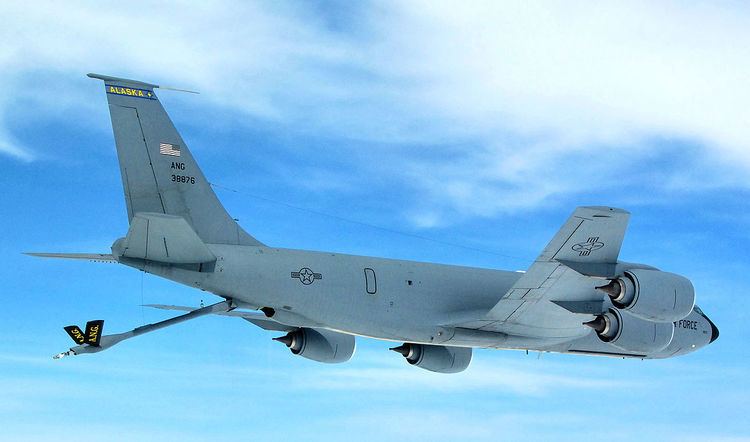Country United States Branch Air National Guard | Allegiance Alaska Type Wing | |
 | ||
Active October 23, 1990 – present Role Air Refueling, Missile Warning, and Space Surveillance | ||
The 168th Air Refueling Wing (168 ARW) is a unit of the Alaska Air National Guard, stationed at Eielson Air Force Base, Fairbanks, Alaska. If activated to federal service as a USAF unit, the 168 ARW is gained by Pacific Air Forces.
Contents
Overview
The 168 Wing is the only Arctic region refueling unit in the United States and maintains a substantial number of personnel on active duty and civilian technician status in order to meet its daily operational requirements. The unit transfers more fuel than any other Air National Guard tanker wing, because nearly all receivers are active duty aircraft, many of which are on operational missions.
The mission of the 168 ARW is to train and equip KC-135R combat crews to provide air refueling in support of PACAF Operations Plans (OPLANS) and worldwide refueling taskings. It's peacetime mission provides air refueling training and exercise support for all 11th Air Force AWACS and fighter aircraft, as well as alert tankers and crews to support Alaska NORAD Region (ANR) plans and Joint Chiefs of Staff-directed refueling requirements.
In 2000, the wing became mobility-tasked, which has been a true opportunity for growth and learning. Besides its federally directed missions, as a unit of the Alaska National Guard, the 168 ARW is an asset of the Governor of Alaska and as such, the Governor can direct the unit to respond to emergencies declared or missions required within the State.
The 168th ARW completed its R-model conversion in 1995, and in 2000 they completed a major flight deck upgrade called "Pacer CRAG" – with the CRAG standing for Compass, Radar, and GPS (Global Positioning System). The Wing's Primary Assigned Aircraft are eight KC-135 R-models assigned to the 168th Air Refueling Squadron. The wing aircraft are identified with a blue tail stripe, and the name "Alaska".
Because of Alaska's strategic location with regard to national defense, the mission and importance of the 168 ARW and the Alaska Air National Guard should continue to increase in the coming years. The 168 ARW has a remarkably broad range of responsibilities.
Units
The 168th Air Refueling Wing consists of the following units:
Emblem
The upper right of the shield consists of a compass rose against a yellow background. The compass rose signifies the global nature of the Wing mission and is set at a 30-degree angle to the east representing the magnetic variation of Alaska where the Group was first formed. The yellow background represents the midnight sun at high latitude and the day aspect of the air refueling mission. The lower left of the shield depicts a red lightning bolt running from cloud to cloud against a blue background. The red lightning bolt signifies the projection of military power, the clouds are the medium in which it performs its mission, and the blue background the Arctic night and the night aspect of its mission. The red lightning bolt is also a prominent feature of the squadron patch from which the 168th Air Refueling Group/Wing evolved. Between the yellow and blue fields is a bar of ultramarine blue containing eight yellow stars. The ultramarine blue is Air Force blue representing the 168 ARW's role in the Total Force; it is also the background color of the Alaska flag. The eight yellow stars are the stars of the big dipper also found on the Alaska flag.
History
Established on 23 October 1990 when the Alaska ANG 168th Air Refueling Squadron was expanded to a group level. The 168th Air Refueling Squadron traces its lineage to the 437th Bombardment Squadron of the 319th Bombardment Group, originally activated at Barksdale Field, Louisiana, in June 1942.
From a modest beginning in 1986, with just four KC-135E aircraft transferred from the Arkansas Air National Guard at Little Rock AFB, the unit has blossomed into Wing status and all the accouterments of a full Air Refueling Wing. The first rendezvous and refueling of the squadron occurred just weeks after the arrival of the first aircraft. The pilot in command was Ltc. Tom Gresch, and the navigator conducting the rendezvous was Capt. Michael R. Stack, formerly of the 126th Air Refueling Wing in Chicago. The 168 ARW has command and control over thirteen subordinate assigned units whose missions include all aircraft maintenance for the PACAF-gained tankers, providing financial, transportation, contracting, and base supply resources, communications, data processing and visual information functions, organizational security, and disaster preparedness and air base operability. They also contain all personnel activities such as training, equal employment opportunity and recruiting, and limited diagnostic and therapeutic service in general medicine, flight medicine, bioenvironmental, environmental, and dental services.
